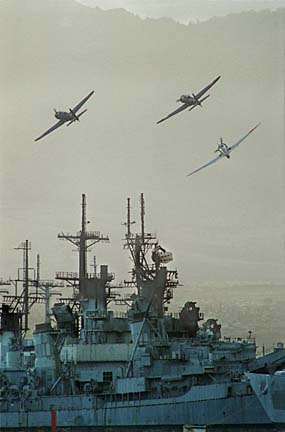Advertisement - Click to support our sponsors.


WITH 2000 almost over, it looks like film and television production was the hottest segment of the local entertainment industry. Complete figures won't be available for at least another month at the earliest but reports in thus far put total production revenues somewhere over $135 million, and a final total of $150 million is not out of the question.
Cameras rolled for 'Pearl Harbor,'
'Baywatch Hawaii' and
'Windtalkers'By John Berger
Special to the Star-BulletinLast year's record breaking total was just shy of $100 million.
"Baywatch Hawaii" continued production here and kept the beauty of Hawaii before a worldwide television audience while also providing a new international venue for contemporary island music.
The impact of the Screen Actor's Guild strike didn't extend to commercials made for the Japanese market.
And then there were the big-budget films that found Hawaii the perfect place for action-dramas set during World War II.
Filming for "Pearl Harbor," a Disney World War II action-romance starring Ben Affleck, Cuba Gooding Jr., and Josh Hartnett, included a
"live" attack by vintage aircraft and use of live explosives to recreate portions of the Japanese attack on the base in 1941.
The elaborate production required a total staff and crew of more than 500 people with at least 67 used for the work here. The Hawaii crew included a number of local hires for work in production units, construction units, set construction and as drivers.
"Windtalkers" stars Nicholas Cage in a story of the Navajo codetalkers who used their ancestral language as the basis for unbreakable codes during World War II.

Filming began in late summer with numerous island residents enlisted as extras to portray American or Japanese soldiers, and others hired for work behind the cameras. It was anticipated that as much as $35 million of the film's estimated $100 million-plus budget would be spent here.In film-related stories:
Al Masini announced in April that he was closing Al Masini Productions and would not produce a second season of "From Hawaii ... Destination Stardom."
Teamsters Local 399 announced in June that it was voluntarily reducing its transportation workers' pay scale for work on syndicated, cable and movie-of-the-week shows in the hope that this would make Hawaii more affordable for outside producers.
Chuck Boller marked his first season as executive director of the Hawai'i International Film Festival as the HIFF celebrated it's 20th anniversary in November. The event was rated by many as the most exciting and diverse in HIFF history. There was no public political meddling by the government of the People's Republic of China regarding award nominees as occurred during the tenure of Boller's predecessor, Christian Gaines. And, rumor had it that the single most popular and hardest-to-get ticket was for the "At the Fringe" programs, which included a 3D porno film. Oh well!
Year 2000 was an uneven one for other forms of entertainment. The local record industry produced about 15 percent fewer titles than in 1999, but local releases collectively sold better.
Waikiki was relatively quiet but Hawaiian music continued to thrive in all the major hotels and Outrigger Entertainment offered something fresh with the revamped YES! Encore Hawaii show on Lewers Street and the Wave Waikiki "turned legal" as it celebrated its 21st anniversary with reunion performances by Sonya & Revolucion and Hat Makes the Man.
The explosive success of "Island Rhythms 98.5" sent shock waves through the local radio industry as the station's new reggae/Jawaiian format provided hard hitting direct competition to longtime reggae/Jawaiian powerhouse KCCN FM 100. By the end of the year "Double K Country" had abandoned country for an urban/rap format similar to that already in place at I-94.
Click for online
calendars and events.